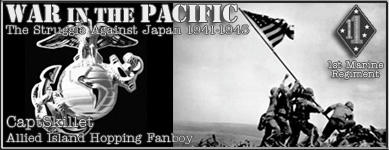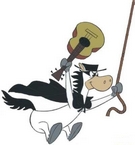captskillet
Posts: 2493
Joined: 3/1/2003
From: Louisiana & the 2007 Nat Champ LSU Fightin' Tigers
Status: offline

|
Found this while researching Peleliu........excellent read.......Capt. Pope would win the Congressional for this Action! 
The deepest penetration the 1st Marines made on the 19th was achieved by C Company, commanded by a 25-year-old Massachusetts native, Captain Everett Pope. At about noon, Pope was ordered to seize Hill 100, a steep, apparently isolated knob which dominated the East Road and the swampy low ground to the battalion’s right front.
Already reduced by casualties to just 90 men [original company strength was just about 400], C Company was in as good a shape for this mission as any of the depleted rifle companies. The Marines approached Hill 100 – later known as Walt Ridge – through a swamp filtering forward past shell-torn tree trunks which jutted skyward like broken fingers. Reaching the road at the base of the height, they found and attacked two large pillboxes but were almost immediately pinned down by machine-gun fire from the right. Firing from only 50 yards away, the Japanese machine gunner was situated on the other side of a pond where the Marines could not get to him. Unable to move forward and taking heavy casualties, Pope requested permission to pull back, pass to the left of the main swamp area and push up the road with tank support.
The road here angled abruptly east, crossing the swamp over the narrow causeway. The single track crossing was located along the mouth of a wide draw, later known as The Horseshoe. It then skirted the base of Pope’s objective and angled northeast.
Pope extricated his men, but it was late afternoon before C Company was able to renew the push. The tank support did not live up to hopes. Trying to negotiate the causeway, the first tank slipped over the edge and stalled. A second tank ventured out to extricate the first and slipped over the other side, blocking the causeway to any more armored support.
Leaving the tanks behind, the Marines rushed across the causeway by squads, paused briefly at the foot of the hill, then started the steep scramble up, backed by mortars and machines guns. Here and there a blasted tree, stripped of its branches, jutted skyward, but there was little cover for the approach. Among the casualties were two Marines killed by U.S. tank fire as they tried to knock out an enemy machine gun.
Enemy fire from Hill 100 and surrounding heights took a heavy toll of the attacking Marines, but by sliding around to the right, some two dozen survivors made it to the summit. There, to their disconcertion, they found the maps were wrong. Hill 100 was not an isolated knob; it was merely the nose of a long ridge dominated by a higher knob only 50 yards to their front.
Pope did not need his Phi Beta Kappa key from Bowdoin College to understand he now had a major problem on his hands. Exposed to fire from the high ground to their front, as well as crossfire from a parallel ridge to the west, he was in a very precarious position.
As twilight fell, the Marines took what cover they could among the jumbled rocks. Their perimeter was very compressed – about the size of a tennis court by Pope’s reckoning – perched on the edge of the cliffs. They had no real ground contact with the rear and only what ammunition they had been able to carry up in the initial assault. Noted the C Company war diary, “The line is flimsy as hell, and it is getting dark. We have no wires and need grenades badly.”
At 1700, a machine gun crew supporting C Company saw six men moving toward Japanese lines. Challenged, the strangers merely crouched down in the road. One of the machine gunners walked over to them, a belt of ammo in his hands. He was on top of the men before he realized they were Japanese. Slapping the lead Japanese in the face with the ammo belt, the Marine knocked him cold. The next Japanese fired at him but missed, his bullet striking an unlucky Marine lieutenant in the jaw and exiting through the back of the officer’s head. The machine gunner shot the six Japanese, but the lieutenant was dead.
The Japanese went for Pope’s men after dark, and they kept coming. At first, they tried to infiltrate the Marine perimeter; then they commenced a series of counterattacks, each made of 20 to 25 men. How many there were and how often they came soon dissolved into a confused blur to the Marines. “The whole night was mixed up,” recalled Pope.
Most of the thrusts came down the ridge. Pope had some radio contact with battalion and received some illumination. What he really needed was artillery support, but he was too closely engaged to call in fire from the big guns.
Back at a company command post, Private Russell Davis listened to the fighting over the radio. The front-line Marines were screaming for illumination or for corpsmen; men were crying and pleading for help, but there was nothing anybody could do to help them. In the CP, Davis’ company commander listened to the whimpering calls from the hills, cursing monotonously and helplessly, his head down between his knees.
Up on the ridge, two Japanese suddenly materialized near the position defended by Lieutenant Francis Burke of Scranton, Pennsylvania, and Sergeant James P. McAlarnis of Kentucky. One of the Japanese ran a bayonet into Burke’s leg. Burke tore into his attacker, beating him senseless with his fists. McAlarnis, meanwhile, went to work on the second Japanese with his rifle butt. They tossed the bodies over the precipice.
Pope’s Marines managed to throw back the Japanese attacks, but as dawn streaked the sky, they were running perilously low on ammunition. “We used rocks,” recalled Pope, “not so much to try to hit them with rocks… but you’d throw a rock and they wouldn’t know if it was a grenade or not and they’d wait a minute to see if it was going to explode. Throw three rocks and then one of your remaining grenades and slow them down a bit.”
As the fighting became hand-to-hand, the Marines pitched some of their attackers bodily over the steep cliffs. Spotting two enemy soldiers climbing the slope to his position, a sergeant heaved an empty grenade box at them, then opened up with his rifle. Private First Class Philip Collins of Gardiner, Massachusetts, picked up Japanese grenades before they exploded and tossed them back. “He did that until one exploded in his hand,” reported Pope. “Then he picked up a rifle and used that until he was too weak to load the weapon.”
Much of the enemy fire focussed on the light machine gun which was taken over by the assistant after the gunner was hit. The gun began jamming after a couple of hours of constant firing, and the gunner had to clear it by hand, exposing himself to enemy fire. “Every time he went up, they threw grenades,” recalled a witness. The gun was finally blown off its tripod, but the gunner kept it in action until he was wounded and unable to continue.
By daylight, down to about a dozen men and out of ammunition, Pope received orders to withdraw. The order came just as the last Japanese assault began to sweep the survivors off the ridge anyway. There was little order. Those who could scrambled down the slope as fast as they could. There had been no question of sparing able-bodied men to evacuate the wounded during the night. Anyone who could not get down on his own was doomed.
Making their way through the light scrub at the base of the hill, the Marines dodged streams of enemy tracers whipping through the brush. Pope’s radioman was killed by his side as he talked on the phone. Japanese infantry could be seen against the skyline where the Marines had been only moments before. Another enemy group came around to the right, where a couple of them proceeded to set up a light machine gun, much to Pope’s discomfiture as he suddenly realized that they had singled him out personally for their attention. He kept moving – fast – until he and the other survivors found cover behind a stone wall near the causeway below.
Of the two dozen or so men Pope had brought up the hill, only nine made it down safely. Of these, many were wounded, including Pope himself. Sometime during the fighting, he had taken a spray of shrapnel in the legs and thighs – an injury he dismissed as “not consequential.” The New Englander picked the metal fragments out with a pair of pliers at the infirmary a couple of days later. He walked off Peleliu, the only company commander in the 1st Battalion to retain his post through the entire operation.
Pope’s survivors were still pulling themselves together at 1630 when the company received orders to attack up a ravine along the ridge they had just lost. Pope contacted regiment and reported that he had only 15 men and 2 officers able to attack. The order was rescinded.
I could read stuff like this all night!!!!!!
_____________________________
"Git thar fust with the most men" - Gen. Nathan Bedford Forrest 
|
 Printable Version
Printable Version









 New Messages
New Messages No New Messages
No New Messages Hot Topic w/ New Messages
Hot Topic w/ New Messages Hot Topic w/o New Messages
Hot Topic w/o New Messages Locked w/ New Messages
Locked w/ New Messages Locked w/o New Messages
Locked w/o New Messages Post New Thread
Post New Thread